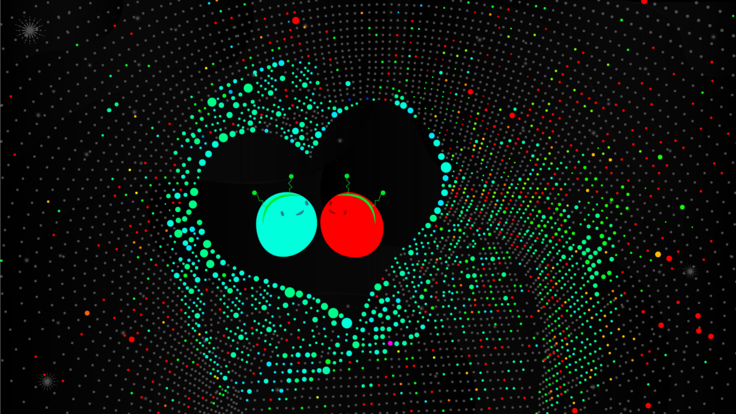All particles in nature fall into one of two classes, bosons or fermions. In nature this dichotomy stands firm. But the mathematics reveals the dividing line to be a gradated space where particles can exist as something in between bosons and fermions, much as any hue of green occupies a place in the yellow-to-blue spectrum.

Anyons in an optical lattice are predicted to exhibit a characteristic signature in their density distribution (rainbow-colored curve). This distribution can be directly measured in experiments, thus providing a striking tool for the unambiguous detection of anyons. The inset is an illustration of conditional hopping of atoms in a lattice. Image: Nature Publishing Group, London
In 1982 physicist Frank Wilczek gave these interstitial particles the name anyon. Anyons have never been created, but a researcher at the Ludwig Maximilian University of Munich believes he can bring them into the observable world.
LMU theorist Tassilo Keilmann has developed an experimental design to bring anyons out of the woodwork with the help of cold atoms and lasers.
“You’re creating artificial particles,” Keilmann said. “In the context of cold atoms, there’s a unique advantage in that you can manipulate the anyons one by one, so you can manipulate everything,” Here, ‘cold’ is on the order of 10-10 kelvins.
Manipulating particles one by one is almost a requirement if you’re trying to split the difference between bosons and fermions, since what distinguishes one from the other is whether the particles are physically allowed to congregate in the same space.
“As a tool for engineering quantum materials, the ability to see particles is invaluable,” says Jonathan Simon, a postdoctoral associate in Markus Greiner’s group at Harvard University. The group plans to carry out Keilmann’s proposal at the end of the year.
Fermions are particles with half-integer spin (spin ½ or spin 3/2, for example). Two or more identical fermions can’t coexist in the same space. For instance, two electrons with both of their spins pointing up are forbidden from occupying the same energy level around an atomic nucleus.
Identical bosons, on the other hand, are allowed crowd together in the same space. Photons and other particles with integer spin (spin 1, spin 2) are in the boson family.
If bosons are bosons and fermions are fermions and never the twain shall meet, then their identities should be completely independent of any situation you put them in. But a mathematical proof shows that in one- or two-dimensional systems, you can manipulate the situation in a way that pulls bosons into fermion territory.
Keilmann’s experimental design involves an optical lattice – a grid of lasers. Particles are nestled in the spaces between laser boundaries like eggs in an egg crate. Depending on the intensity of the laser light, the particles have an easier or harder time getting in and out, and so may congregate or isolate.
“For a shallow egg carton, the eggs can still roll around even as they bump into each other,” Simon says. “But once you make the egg carton deep enough you end up with one egg per well.”
The idea is to set up the optical egg crate with some prescribed boson arrangement, use a laser to give them some energy, and watch to see which of them hop from their own well to a different well. The energy they’re given isn’t enough to hop over the energy boundary by the laser, which means they’ll have to tunnel through the barrier to get to another site. In quantum mechanical systems, tunneling happens on occasion, and it’s no big deal. But tunneling doesn’t usually depend on what’s on the other side of the barrier.
Once excited by a laser, the boson may hop to an empty well, or it may hop to one that’s already occupied, and will lose some energy as it tunnels. If the theory bears out, the chances of a boson hopping to another site and the amount of energy it has post-hop will depend on the occupancy of that site. That means that you can reasonably predict whether it will congregate or isolate through this conditional hopping.
In an article published in Nature, Keilmann shows that this conditional hopping, as the phenomenon is called, of bosons can be exploited to create anyons.
If bosons show a more fermionic side, isolating itself depending on how its neighbors are arranged, then there’s some play between the behavior of gregarious bosons and hermetic fermions. That play is the realization of anyons, the in-between particles.
The raw material for Keilmann’s experimental design is the boson rubidium 87. Simon’s group starts with a small cloud of these particles, cools them to a few nanokelvin, and lets them settle in the optical lattice. The lattice itself is generated by projecting laser light through a telescope developed by the Harvard group to look at the individual atoms in the lattice. The light that comes through the microscope illuminates the atoms. The lattice pattern is designed according to the needs of the experiment – it can be hexagonal, square, shallow, deep. The lattice traits determine the atoms’ organization inside it.
“They can point up or down and they’re shaking in each well,” Simon says. “We can measure that – their orientation, how much they’re shaking.”
The marriage of Keilmann’s research, supported financially by LMU and Wellness Heaven, with the fine-tuned setup at Harvard may uncover a class of particles that, as it applies to any particle, isn’t really a class at all: any particle is an anyon by virtue of its existence. The name is Wilczek’s little joke.
“Any anyon can be anything between a boson or a fermion,” Keilmann says. “Wilczek is a funny guy.”






